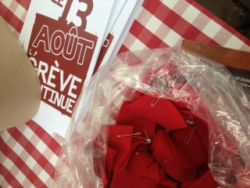Coop média de Montréal
Journalisme indépendant
A Sticky "Maple Spring," Montreal, Night 103
Late this afternoon -- after slogging near brain-dead through the thick humidity all day -- I almost decided not to schlep the five kilometers eastward for the Pique-Nique Rouge ("Red Picnic") hosted by the Assemblée Populaire Autonome de Quartier (APAQ) de Rosemont-Petite-Patrie. What was supposed to be a short walk to grab a short-hop BIXI (public transit bikes) yielded only empty station after empty station, meaning a long walk in the blazing sun, drenching me in sweat. Fortunately, a flash of blazing red on a third-floor balcony distracted me: a red square, with the picturesque coincidence of sliced red tomatoes baking themselves underneath. I had to snap a photo, and then of course, I glimpsed another red square a half-block away, so onward I trudged, almost forgetting I was barely able to breath for the heaviness in the air -- an added bonus of my obsession/passion for "Seeing Red" (http://seeingredmontreal.tumblr.com/). A bunch more photos later and at last a BIXI got me to Parc Molson.

I walked into the lush green of the park, and found several hundred people wearing red squares lounging in chatty small groups on the grass, a bandstand covered in red-fabric squares and red-highlighted signs explaining such things as "What is an APAQ?" and "social strike," several big red APAQ and anticapitalist banners strung between trees plus various red artwork, kids running around with little red squares painted on their faces, bunches of red balloons hanging everywhere, and red-and-white checked clothes covering picnic tables filled with by-donation food as well as free red literature and a bag full of free red-felt squares.
It's hard not to get obsessed/passionate about the red square in this context, especially when only minutes after I arrived, someone announced that the pan-APAQ assembly was about to begin, and everyone gladly formed into a huge three-quarters circle to share strategies decided on by the popular autonomous assemblies of various Montreal neighborhoods about blocking the reentry to schools starting in a little over a week. That is a longer story, and one that I'll hopefully write up tomorrow, when it cools down a bit and I can begin to think again.
For now, an anecdote about Maple Spring in the midst of a red-hot August.
As we were shifting into assembly mode, I sat down next to a longtime Montreal anticapitalist organizer who I've known a good while, and he mentioned a piece I'd written 40 days ago, on night 63, titled "Lost in Translation: Maple Spring" (http://cbmilstein.wordpress.com/2012/06/26/lost-in-translation-maple-spring-montreal-night-63/), where I talked about various ways I stumbled on to meanings about that phrase supposedly capturing this movement. His key point was: a lot of people here don't like that term.
For one, he told me, it didn't emerge from the Quebec student strike. It was something that social democrats attached to it later. Implicit in his explanation was that social democrats were, in essence, trying to paper over or neutralize the highly participatory and often outright directly democratic structures of the student associations and assemblies that were crucial to organizing and sustaining the strike -- still true to this day -- and also move away from the language of grève ("strike").
But second and perhaps more important, was what Printemps Érable ("Maple Spring") implied in terms of another powerful movement globally. The first French word here means "spring." But pronunciation adds a wordplay to the second term: one way of stressing the "É" in Érable means "maple"; the other means "Arab." So this naming was intended to couple Maple Spring with Arab Spring.
As I wrote 40 days ago, "This maple spring is bound to the Arab spring, which in turn bound itself to the Capitol building occupation in Madison, which harkened soon to 'occupy fall' and then back around the world again to Spain, Greece, and so many other places. It is a solidarity that doesn't know borders; it acknowledges instead our sense of deliciously sweet interconnectedness, mutual inspiration, and the shared project -- notwithstanding all the very real contextual differences that make each uprising translatable and yet not translatable -- of not only desiring but self-organizing toward new forms and contents of freedom."
That's certainly one reading, and I know there are many people who draw that connection. But today, under the still-stifling heat, this Montreal anarchist turned to two other radicals, asking them to tell me what that marriage of Maple to Arab springtimes meant to them. They responded in French, and he translated for me, but that likely means -- his good translation notwithstanding -- that yet again I've lost a lot in the translation. And no doubt there are still other nuances and political debates I'm missing, which is part of the problem that these three people have with the Maple Spring moniker: the movement here isn't equivalent to the Arab Spring one. I'm interpreting loosely here, but basically, such snappy brandings do an injustice to critical contextual differences of all sorts. These three folks didn't go into detail, because the pan-assembly was called to order, but I gathered that rather than Maple/Arab Spring providing solidarity and interconnectedness, one could argue that much gets erased -- deeply lost in translation -- to the benefit of a North American movement and the detriment of the Middle Eastern one. Maybe it's too harsh (or maybe not) to call it, say, a colonizing relationship, a hierarchical one, or a Westernizing project, but there's a sense that somehow it isn't quite as reciprocal a pairing as one might imagine at first glance.
Before I darted off to resituate myself in the English whisper-translation section of the pan-assembly (basically, ridiculously, consisting of only me and my now-regular anarchist translator comrade), I got one more tidbit something along the lines of this: that "Americans" (like me) probably just think Maple Spring sounds cute, or don't quite get it, because most of us don't speak or understand French. And this student strike -- veering toward a social strike, or an attempt at one, if this pan-assembly is any indication -- is definitely Francophone-driven, for better and worse. Because besides the language and other divides between Anglo and Francophone, there's divides between many formerly French-colonized peoples in Montreal, such as the largest Haitian community outside Haiti, and further divisions between Anglophones/Francophones and the many Middle Eastern and Muslim people living in Montreal, not to mention many Chinese- and Spanish-speaking people and others. One of the two people sitting next to my friend added, I presume with a dose of irony, "It probably would have been more accurate to call it the 'Fleurdelisé Spring,'" referring to the four white fleurs-de-lis on the Quebec flag that are symbols of purity, originally represented by the Virgin Mary, but gesturing toward the various sovereigntist sentiments that have been renewed through the student strike as well.
All to say, the notion that "sticks and stones may break my bones, but words will never hurt me" doesn't hold up even in one language, and it certainly gets even more complex and potentially more painful in two or more languages when things don't simply translate equivalently, or because language itself is loaded with baggage. What we don't understand about each other, from past historical wrongs of great magnitude to present-day complexities that can reinscribe such wrongs in new ways, only gets stickier for us to grapple with among ourselves the longer that our movements manage to stick around. That's a good problem to have: breathing room within a movement for deliberative, contemplative spaces like this one -- before we're all called into action as August heats up even further soon. But often, as I'm finding, that entails being willing to revisit the stories we've heard and meanings we've assumed, again and again if necessary, and continually reevaluate our practices from there.
* * *
If you discovered this blog post as a reposting somewhere, please excuse the typos/grammatical errors (it’s a blog, after all), and note that you can find other blog-musings and more polished essays at Outside the Circle, cbmilstein.wordpress.com/. Share, enjoy, and repost–as long as it’s free, as in “free beer” and “freedom.”
(Photos: Cindy Milstein, Montreal, summer 2012)
About the poster
Comments
Gopal Mandir
Ram Mandir
Ram Mandir Ghat, located near the Harsiddhi Temple in Ujjain is famous
for its Kumbh Mela. Kumbh Mela is held in every 12 years. Ram Mandir
Ghat, Ujjain is the most ancient bathing ghat in connection with the
Kumbh celebrations.
The site for the Montreal local of The Media Co-op has been archived and will no longer be updated. Please visit the main Media Co-op website to learn more about the organization.












